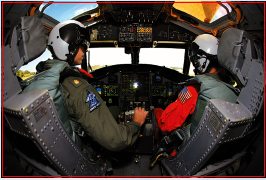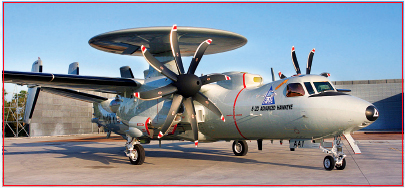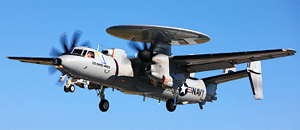|
The clearance has been described by diplomatic
sources as a fallout of the “successful”
visit of Secretary of State Hillary Clinton recently
to India and the signing of the End User Monitoring
Agreement (EUMA) of military equipment being supplied
or sold by the US to India. Like the highly-advanced
Boeing P-8I Maritime Multi-mission Aircraft (MMA),
of which the Indian Navy has already ordered eight
aircraft, the Hawkeye E-2D is the very latest
and “futuristic” and is yet to be delivered
to the US Navy.
India is the second country after the United
Arab Emirates (UAE) to be cleared by the US State
and Defense Departments for sale of this sophisticated
system.
 The
US Navy has sanctioned $ 432 million for trials
of the aircraft currently underway at Naval Air
Station Patuxent River in Maryland. The Naval
Systems Command (NAVAIR) based there provides
engineering and testing support for new naval
systems and weapons. The aircraft is being tested
from August 2007. The
US Navy has sanctioned $ 432 million for trials
of the aircraft currently underway at Naval Air
Station Patuxent River in Maryland. The Naval
Systems Command (NAVAIR) based there provides
engineering and testing support for new naval
systems and weapons. The aircraft is being tested
from August 2007.
The Hawkeye E-2D has been under the US government’s
consideration for India for some time. In fact,
in 2007, sources in Washington had told this writer
that the aircraft was being cleared, but apparently,
the existing version, Hawkeye E-2C, was eventually
offered to which the Indian Navy said ‘No’
in informal discussions.
Hawkeye E-2D looks much the same as a Hawkeye
E-2C but is described by its producers as comfortably
two generations ahead of its existing predecessor.
Notably, Hawkeye E-2C was effectively deployed
for surveillance and battle management in the
1986 US operations against Libya and later against
Iraq in 1991 and 2003.
According to the Federation of American Scientists
(FAS), an organization set up by leading scientists
in 1945 to warn the public and policy makers of
benefits as well as potential dangers from scientific
and technical advances in the wake of nuclear
bombing of Hiroshima and Nagasaki, Libyan aircraft
made 153 attempts to overfly the US fleet off
its shores, but not one was successful, thanks
to the monitoring by Hawkeyes, which directed
carrier-based F-14 Tomcats to Libyan targets.
Technology on board the aircraft has grown since
then due to new generations of sensors as well
as real-time connectivity, which have otherwise
also led to what is now called the Revolution
in Military Affairs (RMA).
Haweye E-2D is being manufactured by Northrop
Grumman, a leading US player in Aerospace, Warships,
Missiles, Combat Radars and Electronic Warfare
systems.
Northrop Grumman’s programme Manager for
International Business Development Tom C Trudell
told India Strategic that the aircraft
has “just been cleared by the US Government
for India” and that a presentation was made
to the Indian Navy late-August in New Delhi.
 Indian
Navy officers had witnessed the capabilities of
the existing Hawkeye E 2C but told the US officials
that as the equipment it would buy would be used
for years, it must be the best and the latest
with future capability insertion potential. Indian
Navy officers had witnessed the capabilities of
the existing Hawkeye E 2C but told the US officials
that as the equipment it would buy would be used
for years, it must be the best and the latest
with future capability insertion potential.
Indian Naval officials say that the technology
onboard the Hawkeye E-2D is “very tempting”
and that although neither the Gorshkov aircraft
carrier which India is buying from Russia nor
India’s first aircraft carrier indigenously
being built would be able to accommodate this
aircraft, India’s future aircraft carriers
could be a little bigger.
“By the time this aircraft comes, and by
the time the Indian Navy gets used to it from
initial shore-based operations, plans for two
more aircraft carriers could be amended to house
this system.”
With three aircraft carriers projected to be
acquired by the Indian Navy in the coming decade,
and possibly also for use around island territories,
India could have a total of four or five Hawkeyes
for shipboard and shore-based operations. The
aircraft would also be useful to cover the few
nuclear-propelled and nuclear-armed submarines
that India is building.
The US Navy however uses a squadron of four
aircraft for each of its carrier battle groups.
It may be noted that if the Indian Navy decides
to acquire this aircraft, it would require around
two years for procedural clearance from the Ministry
of Defence and a request to the US government
for purchase under its Foreign Military Sales
(FMS) programme. Then the manufacturer would need
three years to deliver the first of the ordered
number of aircraft.
There have been no tenders or RfPs yet for the
Hawkeye E-2D, but then companies from worldwide
present their wares to various countries either
by themselves and at their own cost, or make offerings
in response to Request for Information (RfI) which
are floated in routine by all the armed forces
to know what is available in terms of newer generation
of systems.
Future aircraft carriers of the Indian Navy
would also have to be equipped with catapult launching
systems, for which it is already looking around.
The catapult system had been developed by the
British, but the technology is largely now with
US companies.
 India’s
second and third aircraft carriers should have
this facility along with lifts and adequate open
area for what is called free deck takeoff. India’s
second and third aircraft carriers should have
this facility along with lifts and adequate open
area for what is called free deck takeoff.
The Mig 29Ks that the Indian Navy is buying
for Gorshkov, will be launched by a ski ramp.
Tip to tip, the Hawkeye is a bigger aircraft than
the Mig 29.
Trudell said that although Northrop Grumman
had been allowed to make presentations to the
Indian Navy, its sale would have to be direct
between the Indian and US governments under the
Foreign Military Sales (FMS) programme. There
are many systems on board, developed for and the
cost of US Navy, which only the US Government
can clear for transfer to other countries.
The US Navy has initially ordered five Hawkeye
E-2Ds under a Low Rate Initial Production (LRIP)
programme, and the first aircraft should be delivered
to the US Navy in 2011.
Hawkeye E-2D is equipped with Northrop Grumman’s
APY-9 combat radar, which has the Active Electronically
Scanned Array (AESA) capability, much like what
the Indian Air Force is looking for in its Medium
Multi Role Combat Jet (M-MRCA) requirement. This
technology is a derivative of what the US Air
Force is using on its most advanced fighter aircraft,
the F-22 Raptor.
 Other
systems onboard include satellite connectivity,
an advanced mission computer with backup, improved
engines, a new glass cockpit and midair refuelling
capability. Although its rotodome would use electronic
radar scanning, it would be moveable for better
surveillance and multi-target engagement. Other
systems onboard include satellite connectivity,
an advanced mission computer with backup, improved
engines, a new glass cockpit and midair refuelling
capability. Although its rotodome would use electronic
radar scanning, it would be moveable for better
surveillance and multi-target engagement.
The existing version is believed to be capable
of tracking more than 2000 targets up to 600 km.
Details about the new aircraft are not officially
available for publication.
Unlike the Boeing P-8I though, it would carry
no weapons.
India can get the aircraft within three years
of a contract being signed, said Trudell.
At present, Hawkeye variants are used by seven
countries besides the US, namely, France, Taiwan,
Egypt, Japan, Mexico, Israel and Singapore.
|